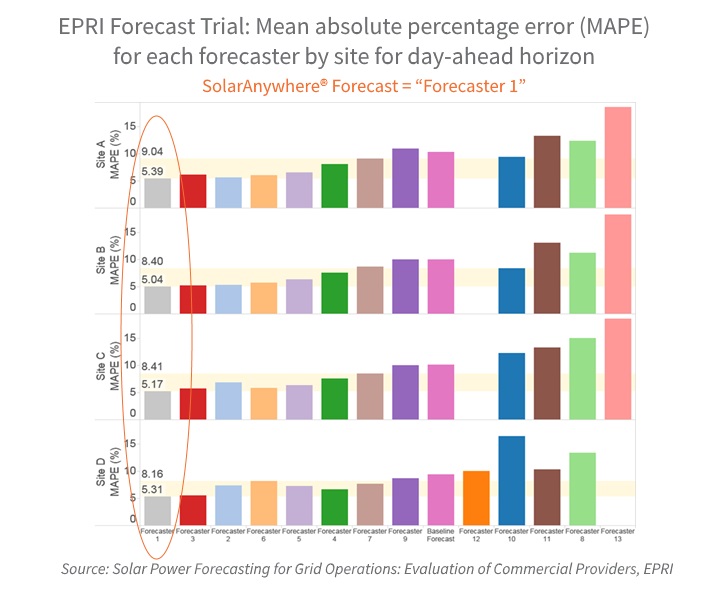The Electric Power Research Institute (EPRI) recently completed a solar forecasting trial designed to help utilities understand the value that accurate solar prediction can bring to their energy market schedules and balancing operations. SolarAnywhere® FleetView® fared well in the trial, displaying the highest levels of accuracy in its PV generation forecasts as compared to datasets from 12 vendors included in the trial.
FleetView was developed in collaboration with the California Public Utilities Commission and the U.S. Department of Energy SunShot Initiative to generate customer-sited and transmission-tied PV forecasts for all the systems in the state of California. Today, FleetView forecasts are available across the Continental U.S. and Hawaii.
FleetView uses real time irradiance measurements generated through satellite sensing techniques to provide projections of PV output on a highly granular spatial grid with the capability to forecast generation down to 1-minute intervals. FleetView leverages forecasting techniques that provide accuracy on an individual system basis, while also applying patented techniques to aggregate PV fleet production to a meaningful level, both at the scale and speed that utilities and ISOs require to support their market needs.
How solar forecasts help utilities and ISOs manage costs
Solar PV assets are installed behind-the-meter and at the transmission level; however, these two types of assets are managed differently by the grid operator and the electric utility. Transmission-level PV participates in the generating side of the balancing equation, whereas behind-the-meter PV often reduces the consumption side. As PV costs decrease and PV begins to replace aging, conventional power generators at the transmission level, it becomes increasingly important for utilities to understand the contribution of these variable generators.
Accurate solar forecasts add value to energy markets because they reduce the imbalance in predictions of supply and demand. Trials such as this one quantify the accuracy of solar forecasts for utilities and ISOs, giving them intelligence on how to predict the solar output of real PV generating assets.
Forecasts from Clean Power Research proven most accurate in EPRI study
FleetView generates PV plant production forecasts by incorporating a diverse set of physical and empirical weather-based models to produce irradiance predictions. The irradiance and other weather data generated are then used in PV simulation models to forecast PV energy and power output for specific systems.
In the EPRI study, forecasts from all 12 vendors were compared to the metered output of systems at four test locations. Error metrics designed by EPRI for Southern Company were calculated for each test site to produce a quantifiable comparison between each of the vendor submissions. FleetView, as depicted below, performed optimally at all locations, as evaluated for absolute accuracy and minimal outliers.

The FleetView forecast not only performed the best across the entire trial, it was significantly more accurate than the other competitors at the start of the trial. This indicateds that the FleetView forecast model doesn’t need time to learn from site feedback, and was still the best even after other forecasters trained their forecast.
EPRI hones forecast trial to increase result value
EPRI designed the forecast trail based on their experience with electric utilities in areas of energy generation, power distribution and utilization. Some key differentiators to this trial include:
- Comparisons spanned more than one-year – This ensured forecasts were evaluated across all seasonal variation.
- Increased depth of participation and number of test sites – The study included 12 vendors that supplied forecasts for four operating PV generators across varied U.S. climate zones.
- Non-biased study – Anonymous submissions from each vendor ensured that neither EPRI nor Southern Company knew which forecast vendor supplied what forecast data.
What’s next for SolarAnywhere
As the amount of PV continues to grow at both the transmission-level and behind-the-meter, PV forecasts will increase in importance for managing grid operational costs. Incremental improvements in solar forecast accuracy lead directly to reduced costs by allowing the market to limit procurement of short-term, more costly energy.
While trials such as this EPRI study validate the investment to FleetView to date, further development is targeted at emerging forecast technologies, such as higher resolution numerical weather prediction grids and machine learning.
Learn more about behind-the-meter forecasting in the whitepaper: Behind-the-Meter Intelligence for Distributed PV Grid Integration.
Learn more about utility-scale forecasting in the article: What is the value of accurate solar forecasting for utility-scale PV plants?
